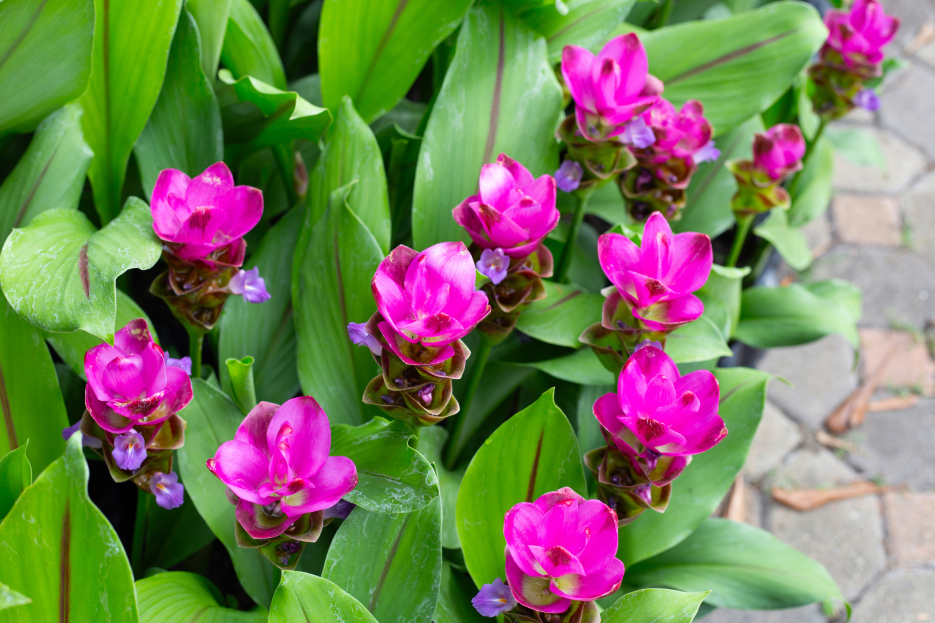
Curcuma, also known as Turmeric or Zedoary, is a stunning tropical plant admired for its striking foliage and vibrant, showy flowers. Related to ginger, Curcuma is commonly grown for its beautiful, orchid-like blooms and its edible rhizomes. This plant is relatively easy to care for, provided it has the right environment. Whether grown indoors as a decorative piece or outdoors in the garden, Curcuma adds a bold, tropical flair to any space. Here’s a detailed guide on how to keep your Curcuma plant thriving.
Curcuma plants grow best in bright, indirect light but can tolerate some direct sunlight. However, prolonged exposure to harsh, direct sunlight may scorch their leaves. Indoors, place the plant near a north or east-facing window where it can receive gentle, indirect light for most of the day. Outdoors, choose a spot with partial shade or filtered sunlight to protect it from the intense midday sun.
Curcuma plants prefer consistently moist soil, though overwatering can lead to root rot. Water regularly, keeping the top inch of soil moist without letting it become soggy. During the growing season, especially in spring and summer, avoid letting the soil dry out completely. In the winter, when the plant goes dormant, reduce watering and let the soil dry out slightly between waterings. Always use well-draining soil and a pot with drainage holes to prevent water from accumulating.
For healthy growth, Curcuma thrives in rich, well-draining soil that holds moisture without becoming waterlogged. A mix of organic matter like peat moss combined with perlite or coarse sand works well. A general-purpose potting mix with added perlite or sand is a good option. Ensure the pot has sufficient drainage to prevent the roots from sitting in water.
Being tropical plants, Curcuma flourishes in warm, humid conditions. It grows best in temperatures ranging from 65-85°F (18-29°C) and should be kept away from temperatures below 50°F (10°C), which can cause damage. High humidity is essential, ideally around 60% or more. To boost humidity, place the plant on a tray of water and pebbles or use a nearby humidifier.
During the growing season, Curcuma benefits from regular feeding to support vibrant foliage and blooming. A balanced liquid fertilizer, diluted to half strength, works well when applied every 4-6 weeks from spring through late summer. Once the plant enters dormancy in fall and winter, stop fertilizing, as it won’t need extra nutrients while it's resting.
Curcuma plants require minimal pruning. Regularly remove dead or yellowing leaves to keep the plant neat and healthy. Once the flowers have finished blooming, trim back the flower stalks to encourage new growth. Keeping the area around the plant clear of fallen leaves and debris helps prevent pests and disease.
Curcuma plants are loved for their stunning, colorful summer blooms, which range from white and yellow to pink and purple, depending on the variety. To encourage blooming, make sure the plant gets enough light, stays warm, and receives consistent moisture throughout the growing season. Be patient — Curcuma may take time to bloom, but the gorgeous flowers are worth the wait.
The easiest way to propagate Curcuma is by dividing its rhizomes in spring when the plant starts growing actively again. Gently remove the plant from its pot and separate the rhizomes, ensuring each division has roots and at least one healthy shoot. Replant the divisions in fresh soil and water lightly. Place the new plants in a warm, humid environment to help them establish and grow.
Yellowing leaves often indicate overwatering or poor drainage, so it’s important to adjust your watering schedule and check that the plant isn’t sitting in water. Curcuma can attract pests like mealybugs or aphids — if you notice them, treat the plant with neem oil or insecticidal soap. If your Curcuma isn’t flowering, it may need more light or a rest period during dormancy to bloom again.
Curcuma plants are non-toxic to pets, which make them a safe choice for homes with animals. Still, it’s best to discourage pets from chewing on the leaves to keep both the plant and your furry friends safe.